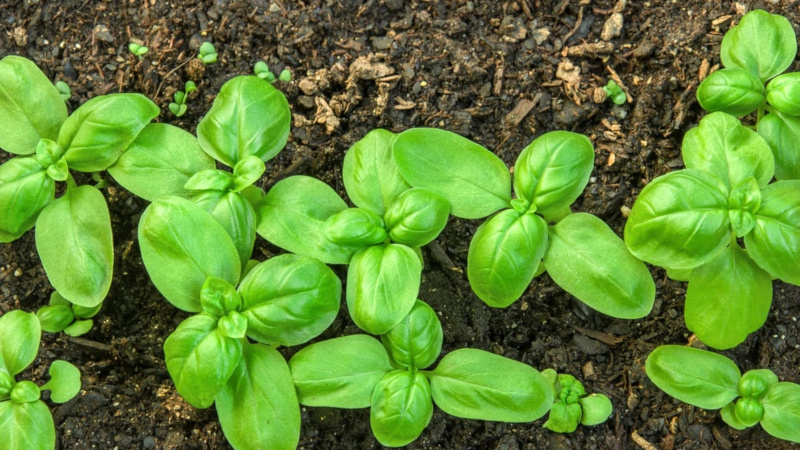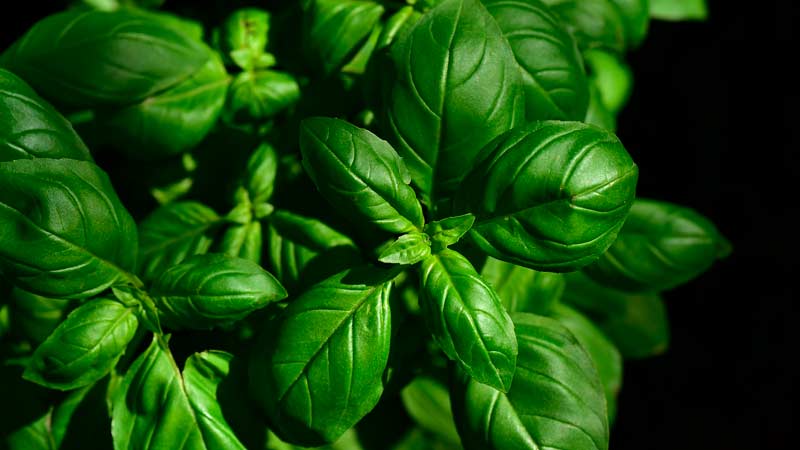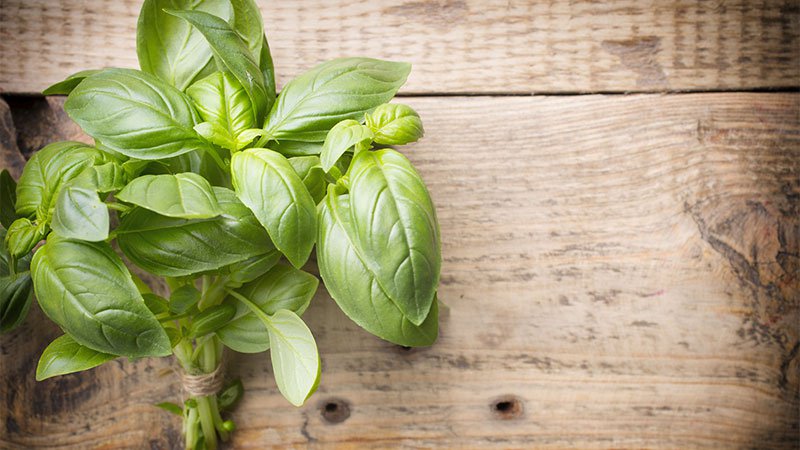Vegetable garden all year round: is it possible to plant basil before winter and how to do it right
Basil is a thermophilic herb popular with culinary experts around the world. The need for it is unabated all year round. A fragrant plant is planted in winter for seedlings, at the beginning of summer on the site. To enjoy the spice throughout the year, starting in early spring, many gardeners plant basil before winter.
The content of the article
Is it possible to plant basil before winter

Since basil is a thermophilic, gentle plant, planting seeds in open ground before winter is possible only in the southern regions, where winters are warm, snowless.... Autumn plantings are insulated for the winter. In spring, with the establishment of warm weather, seedlings appear.
In other climatic zones, podzimny planting of fragrant spices is done only at home. On household plots in winter, a heat-loving culture will not withstand a drop in soil temperature to minus values. Therefore, the best option is to sprout basil at home.
Advantages and disadvantages of winter sowing
The advantages of winter sowing include:
- getting greens in early spring;
- ease of care for home growing;
- containers with crops are easy to move to a suitable place;
- Sown in the southern regions in open soil, basil is hardened in the soil.
Disadvantages of winter sowing:
- if the temperature drops significantly, the basil grown on the site may die;
- with insufficient sunlight in early spring, seedlings will be elongated, thin.
Suitable varieties
The most common varieties for winter growing include:
- Basil vegetable Marquis - mid-season cold-resistant variety. Ripening period is 55-60 days. The variety is distinguished by a profusely branched, semi-spreading bush with a strong erect stem. The height of the bush is 22-25 cm. The leaves are rich green, small, smooth, elliptical. The edges of the leaves are weakly serrated. Flowers are white. The weight of the bushes reaches 140-150 g. The yield of vegetable basil is 1.3-1.5 kg / m². The variety is characterized by a strong peppery-clove aroma. Approved for cultivation in all regions of the country.
- Clove - an early ripe variety, 35-40 days pass before the first cut. The bush is compact, well leafy, 30-37 cm high. The leaves are bright green, elongated, the edges are jagged. Flowers are small, white, gathered in bunches. The leaves exude a clove scent with aniseed notes. The variety is grown by seedling in a greenhouse, transplanted into open ground in June. When grown at home, flowering continues throughout the year.
- Yerevan (Mexican) purple - basil, which has the aroma of freshly brewed tea with notes of allspice black pepper. It is a high-yielding variety producing up to 3 kg / m². The growing season lasts 140-150 days, which allows you to cut the leaves 2-3 times per season. The strong aroma of purple basil is not tolerated by mosquitoes, midges. Planted near the house, Yerevan basil serves as a good deterrent to blood-sucking insects.
Due to the regular removal of peduncles, pinching of young shoots, the plant turns into a well-leafy, strong bush. The variety is used fresh, as a seasoning for salads. The combination of purple leaves and pink flowers looks beautiful when decorating lawns.
Landing dates
In a warm climate, mild winters, autumn sowing of spices in open ground is carried out in October-November. For home cultivation in all other regions, planting of seeds begins in December, the resulting seedlings are planted in greenhouses at the end of March - in April.
Young bushes are planted in open ground at the end of May - June, when the soil warms up to + 15 ° C and the threat of return frosts disappears. Planting dates depend on the weather conditions of the growing region.
Preparation of planting material and soil

For planting basil, choose long plastic containers, wooden boxes, flowerpots... The container should be 25-28 cm high, spacious so that the basil bushes do not darken each other. First, a drainage layer of expanded clay is poured into the containers at the bottom, then fertile, light earth.
The finished substrate is bought in garden centers or prepared independently. To do this, take garden soil, peat, humus, sand in a ratio of 1: 4: 1: 1. To disinfect the substrate from pathogens and the larvae of insect parasites in it, it is heated in the oven for 30-40 minutes.
Before planting, the seeds are soaked for 3-4 hours in warm water to dissolve the essential oils that cover the seeds. The presence of these oils will hinder seed germination. Then the seeds are immersed for 1 hour in a pink solution of potassium permanganate for disinfection, elimination of pathogenic fungi.
Sowing technology
When planted in open ground before winter, the seeds are planted dry, without soaking, since the wet ones will freeze in cold soil and lose their ability to germinate. If planting seeds is carried out at home, use treated seed material.
Seeds
When planting spice seeds in an open area before winter, make beds 2-2.5 cm deep so that the layer of earth does not allow them to freeze. Seeds are placed at a distance of 8 cm from each other. A gap of 15-20 cm is left between the rows.
The soil is not watered so that the seeds do not germinate before the onset of spring, lay a layer of mulch on it. A shelter made of agrofibre is made over the beds, pulling it onto a frame installed around the site. This will create an air gap to prevent the seeds from freezing.
When grown at home, the processed and dried seeds on a paper towel are placed in prepared containers with a nutrient substrate. Grooves are made on the soil with a depth of 1 cm, moistened with warm water, seeds are placed at a distance of 2 cm, an interval of 7-8 cm is maintained between rows.
Seeds are covered with a thin layer of substrate, compacted a little by hand. The container is covered with transparent plastic wrap, moved to a warm, bright place. The best place for seedlings to germinate is a windowsill, under which there are warm radiators. To eliminate condensation, the film is periodically lifted, providing air access.
Attention! A spray bottle is used to moisten the soil, since the water jet will wash out a thin layer of soil and wash the seeds out.
After emergence, the film is removed. Seedlings continue to be grown on sunny windowsills or under LED lamps. Thickened plantings of basil are thinned out, increasing the distance between shoots to 8-10 cm. Weaker specimens are planted in separate peat pots, where they will gain strength for subsequent planting in greenhouses.
Through seedlings
Fortified seedlings dive to the beds in the greenhouse in early April. Seedlings are carefully removed from the common container along with the soil so as not to damage the root system. Each plant is placed in a separate moistened well, deepened to the first lower leaves. A gap of 15 cm is left between the shoots, 25 cm between the rows.
The temperature in the greenhouse is maintained at + 23 ... + 25 ° С. The room is regularly ventilated. Young plants are watered with warm, settled water. Every 2 weeks they are fed with complex fertilizers. The introduction of nitrogen contributes to the rapid growth of green mass.For feeding, 15 g of urea is diluted in 10 liters of water. Watered with a cold solution under the root.
The introduction of potassium, phosphorus stimulates the active production of essential oils... Phosphorus-potassium dressing is carried out 15 days after nitrogen. To do this, use the composition: 20 g of superphosphate, 15 g of potassium sulfate is diluted in 10 liters of water. Mineral dressings alternate with the introduction of organic matter. Prepare solutions of poultry droppings, manure, wood ash. After watering, the beds are loosened, weeds are removed.
It is interesting:
Experienced housewives will tell you whether it is possible to salt early cabbage for the winter.
How to properly cover an apricot for the winter and prepare a tree for cold weather.
Step by step instructions on how to properly cover the figs for the winter and prepare the tree.
Further care

Basil is planted in open ground in early June. A sunny plot is allocated for culture. The soil is prepared in autumn by digging it up with the introduction of wood ash, dry manure (1.5 kg / m²), superphosphate (40 g / m²), potassium nitrate (20 g / m²).
Watering is carried out in the morning with warm water. For the plant, periodic irrigation of the leaves with a spray bottle is useful. Watering is carried out as the topsoil dries up. The basil needs regular pinching to promote the growth of additional shoots.
Important! After cutting the apical shoots, the plant needs additional watering.
The culture is fed with organic matter: solutions of chicken manure (1:20), dry mullein (1:10). Top dressing is carried out only on moist soil. During the growth of the basil, weeds are regularly removed, the beds are loosened. The buds that have appeared are removed, since the greens begin to taste bitter during flowering.
Protection against diseases and pests
The most common basil diseases are:
- Yellowing leaves - bright green leaves turn yellow. The reason lies in the lack of nutrients in the soil. The problem is eliminated by the introduction of complex fertilizers.
- Rolling the leaves observed with excessive watering.
- Falling leaves occurs as a result of drying out of the soil.
- Blackleg appears in conditions of waterlogged soil. The stem of the plant at the soil level darkens, becomes soft, the plant falls. The affected shoots are removed, the remaining ones are treated with a solution of copper sulfate (5 g / 2 l of water).
- Fusarium - appears as black dots on the leaves. The disease occurs in conditions of high temperature and high humidity. The leaves curl, turn black, and the stem gradually darkens. In the initial stage, the disease is treated with an infusion of onion peel (1: 4), it is prepared for a day, the bushes are sprayed.
Dangerous plant pests:
- Aphid - feeds on sap of leaves and stems. Signs of its appearance - curling of the edge of the leaves, slow growth of the stem, sugary discharge on the leaves. To combat the parasite, infusions of garlic, onions, tomato tops, and yarrow are used. Treatments are carried out every 7 days.
- Slugs - eat young shoots. To eliminate slugs between the bushes, sprinkle grated eggshells, dry coffee grounds.
The nuances of growing in a greenhouse and open field
The conditions for growing basil outdoors are different from greenhouse cultivation. The microclimate of the greenhouse allows planting spices, regardless of the climatic conditions of the region.
In greenhouse conditions, the spice actively grows and develops, since it is not affected by changes in day and night temperatures.
The greenhouse can be harvested throughout the year.
Open-planted basil needs shelter when temperatures drop at night. Its cultivation directly depends on weather conditions.
Harvesting

The basil begins to bloom in mid-July. At this point, the plant has developed into a well-leafy bush.
The herbs of the spicy plant are cut off selectively. For this, the longest shoots with well-developed leaves are selected. The apical part of the stem 3-4 cm long is carefully cut with scissors.Pruning stimulates the bush to grow new side shoots. Thus, the farmers harvest three times per season.
Spices are harvested before flowering, since at this time the greatest concentration of essential oils and nutrients is concentrated in the leaves. Cut shoots are consumed fresh or dried for long-term storage. Greens are washed with water, tied with a thread in a bunch, suspended by the stems in a dry room.
Some housewives dry the fragrant plant in the oven for an hour at a temperature of + 40 ° C. The main thing is not to overexpose in time so that the basil does not lose its beneficial properties. The degree of leaf dryness is determined by a slight crunch when compressed. The dried spice is placed in a glass jar with a sealed lid, placed in a dry storage place. The dried plant retains its aroma for a long time.
Conclusion
Basil is a popular healthy spice. Aromatic herbs are added to salads, meat and fish side dishes. The need for fresh herbs exists at any time of the year. Many gardeners have mastered the winter planting of basil.
Subject to correct cultivation techniques, the fragrant spice will produce healthy greens until late autumn.